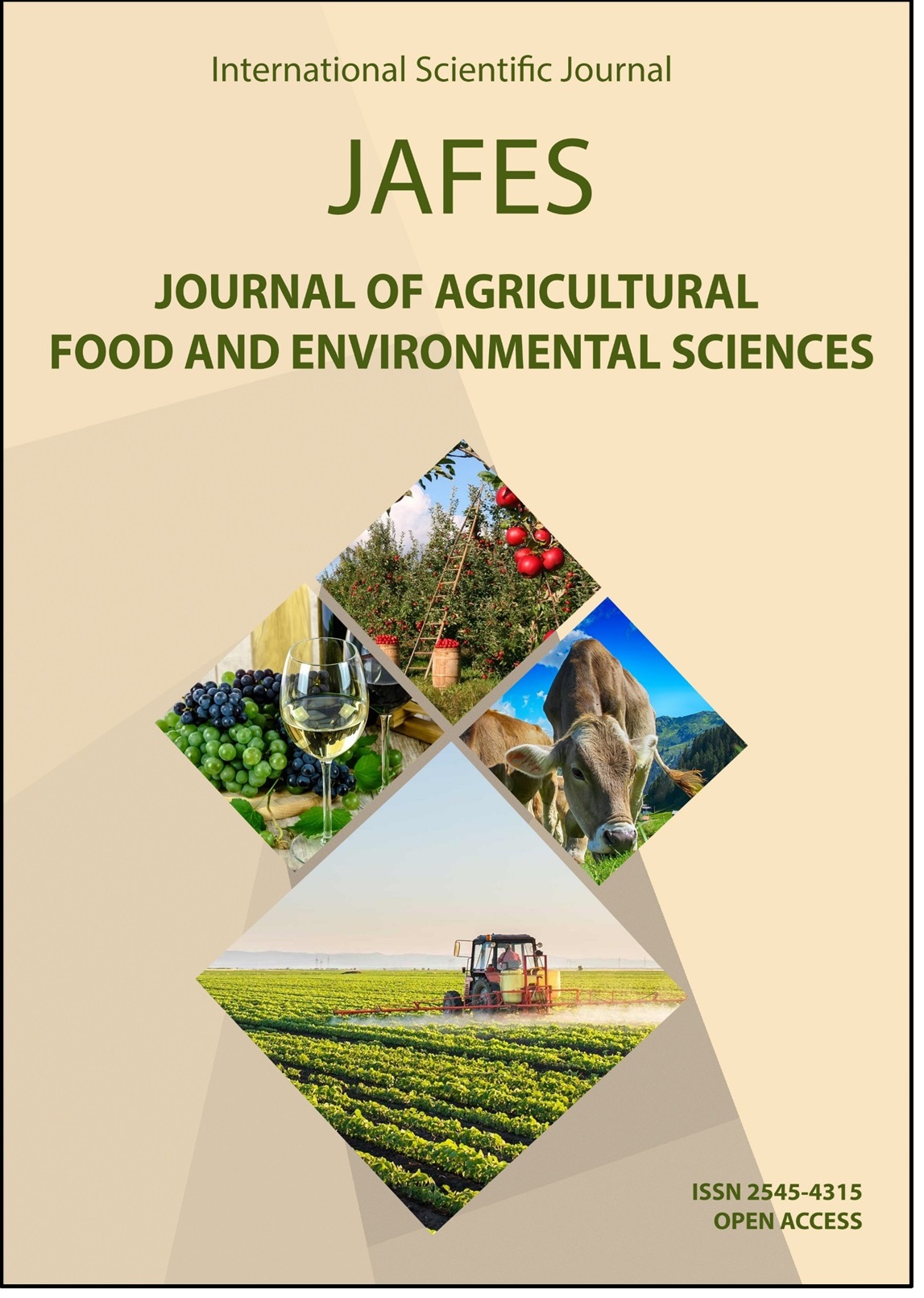CHARACTERIZATION OF CLOVE OIL WITH A FT-IR ATR SPECTROSCOPIC METHOD
Клучни зборови:
Eugenol, TLC method, Steam distillation, Ultrasonic assisted extractionАпстракт
Clove oil possesses excellent antioxidant and antimicrobial properties, while the main components of clove oil are eugenol, acetyleugenol and caryophyllene. Two types (ground and buds) of clove were used in the analysis. The clove essential oil was obtained using a steam distillation and an ultrasonic assisted extraction method. The separation of eugenol from other components was achieved with benzoyl chloride reaction. The analysis of clove oil was with a FT-IR ATR spectroscopic method along with the use of a TLC method using mobile phases, toluene:ethyl acetate (9.3:0.7 v/v), phase A and chloroform:hexane (1:2 v/v), phase B. The UV-Vis spectrum of eugenol was with maximum at 280 nm. The obtained yield was found to be 8.79% and 12.41% for ground clove and 1.36% and 6.75% for clove buds using ultrasonic assisted extraction method, respectively. The characteristic band for the ester group C-O of eugenol acetate was observed at 1765 cm-1. The Rf value for eugenol was 0.66 with phase A, and 0.46 using phase B. The methods were easy to be handled, rapid and can be used in the routine analysis.
Референци
Bell, C. E., Taber, D. F., & Clark, A. K. (2001). Organic chemistry laboratory with qualitative analysis: standard and microscale experiments, 3rd ed.; Harcourt College Publishers.
Cassel, E., Vargas, R. M. F., Martinez, N., Lorenzo, D. & Dellacassa, E. (2009). Steam distillation modeling for essential oil extraction process. Industrial Crops and Products, 29(1), 171-176.
Cortés-Rojas, D. F., De Souza, C. R. F., & Oliveira, W. P. (2014). Clove (Syzygium aromaticum): a precious spice. Asian Pacific Journal of Tropical Biomedicine, 4(2), 90-96.
Gülçin, A., Elmastaş M., & Aboul-Enein, H. Y. (2012). Antioxidant activity of clove oil - A powerful antioxidant source. Arabian Journal of Chemistry, 5(4), 489-499.
Ibrahim, S. M., Al-Zubaidi, L. A., Adnan, S. A., Jessim, A. I., & Jasim, A. I. (2015). Antioxidant activity of purified Eugenol compound in some dairy products. International Journal of Advanced Research, 3(4), 186-195.
Kapadiya, S. M., Parikh, J., & Desai, M. A. (2018). A greener approach towards isolating clove oil from buds of Syzygium aromaticum using microwave radiation. Industrial Crops and Products, 112, 626-632.
Khalil, A. A., Rahman, U., Khan, M. R., Sahar, A., Mehmood, T., & Khan, M. (2017). Essential oil eugenol: sources, extraction techniques and nutraceutical perspectives. Royal Society of Chemistry Advances, 7, 32669-32681.
Jirovetz, L., Buchbauer, G., Stoilova, I., Stoyanova, A., Krastanov, A., & Schmidt., E. (2006). Chemical composition and antioxidant properties of clove leaf essential oil. Journal of Agricultural and Food Chemistry, 54(17), 6303-6307.
Kumar, U., Kumar, B., Bhandari, A., Kumar, Y. (2010). Phytochemical investigation and comparison of antimicrobial screening of clove and cardamom. International Journal of Pharmaceutical Sciences and Research, 1(12), 138-147.
Móricza, Á. M., Horváth, G., Böszörményi, A., & Ott, P. G. (2016). Detection and Identification of Antibacterial and Antioxidant Components of Essential Oils by TLC-Biodetection and GC-MS. Natural Product Communication, 11(11), 1705-1708.
Park, S. H., Sim, Y. B., Lee, J. K., Kim, S. M., Kang, Y. J., Jung, J. S., & Suh, H. W. (2011). The analgesic effects and mechanisms of orally administered eugenol. Archives of Pharmacal Research, 34(3), 501-507.
Rodríguez, O., Sánchez, R., Verde, M., Núñez, M., Ríos, R., & Chávez, A. (2014). Obtaining the essential oil of Syzygium aromaticum, identification of eugenol and its effect on Streptococcus mutans. Journal of Oral Research, 3(4), 218-224.
Rojas, J., Cabrera, S., Benavides, J., Lopera, Y., & Yarce, C. J. (2021). Lipidic Matrixes Containing Clove Essential Oil: Biological Activity, Microstructural and Textural Studies. Molecules, 26(9), 2425.
Sanghai, D. N., Adhate, P. S., Patil, S. K., & Sanghai, N. N. (2011). Development of analytical techniques for identification of phytochemicals in selected herbal drugs. International Journal of Pharmaceutical Sciences and Research, 2011, 2(8), 2126-2131.
Saran, S., Menon, S., Shailajan, S., & Pokharna, P. (2013). Validated RP-HPLC method to estimate eugenol from commercial formulations like Caturjata Churna, Lavangadi Vati, Jatiphaladi Churna, Sitopaladi Churna and clove oil. Journal of Pharmacy Research, 6(1), 53-60.
Tekin, K., Akalın, M. K., Şeker, & M. G. (2015). Ultrasound bath-assisted extraction of essential oils from clove using central composite design, Industrial Crops and Products, 77, 954-960.
Xie, Y.; Yang, Z.; Cao, D.; Rong, F.; Ding, H., & Zhang, D. (2015). Antitermitic and antifungal activities of eugenol and its congeners from the flower buds of Syzgium aromaticum (clove). Industrial Crops and Products, 77, 780-786.
Vanin, A. B., Orlando, T, Piazaz, S. P., Puton, B. M. S., Cansian, R. L., Oliveira, D., & Paroul, N. (2014). Antimicrobial and antioxidant activities of clove essential oil and eugenyl acetate produced by enzymatic esterification. Applied Biochemistry and Biotechnology, 174(4), 1286-1298.
Yugatama, A., Ardiyati, N. W., & Yulianti, I. (2017). Optimation of ethanol concentration in extraction of eugenol from galangal rhizome. Asian Journal of Pharmaceutical and Clinical Research, 10(14), 18-20.
Yun, S. M., Lee, M. H., Lee, K. J., Ku, H. O., Son, S. W., & Joo, Y. S. (2010). Quantitative analysis of eugenol in clove extract by a validated HPLC method, Journal of AOAC International, 93(6), 1806-1810.



